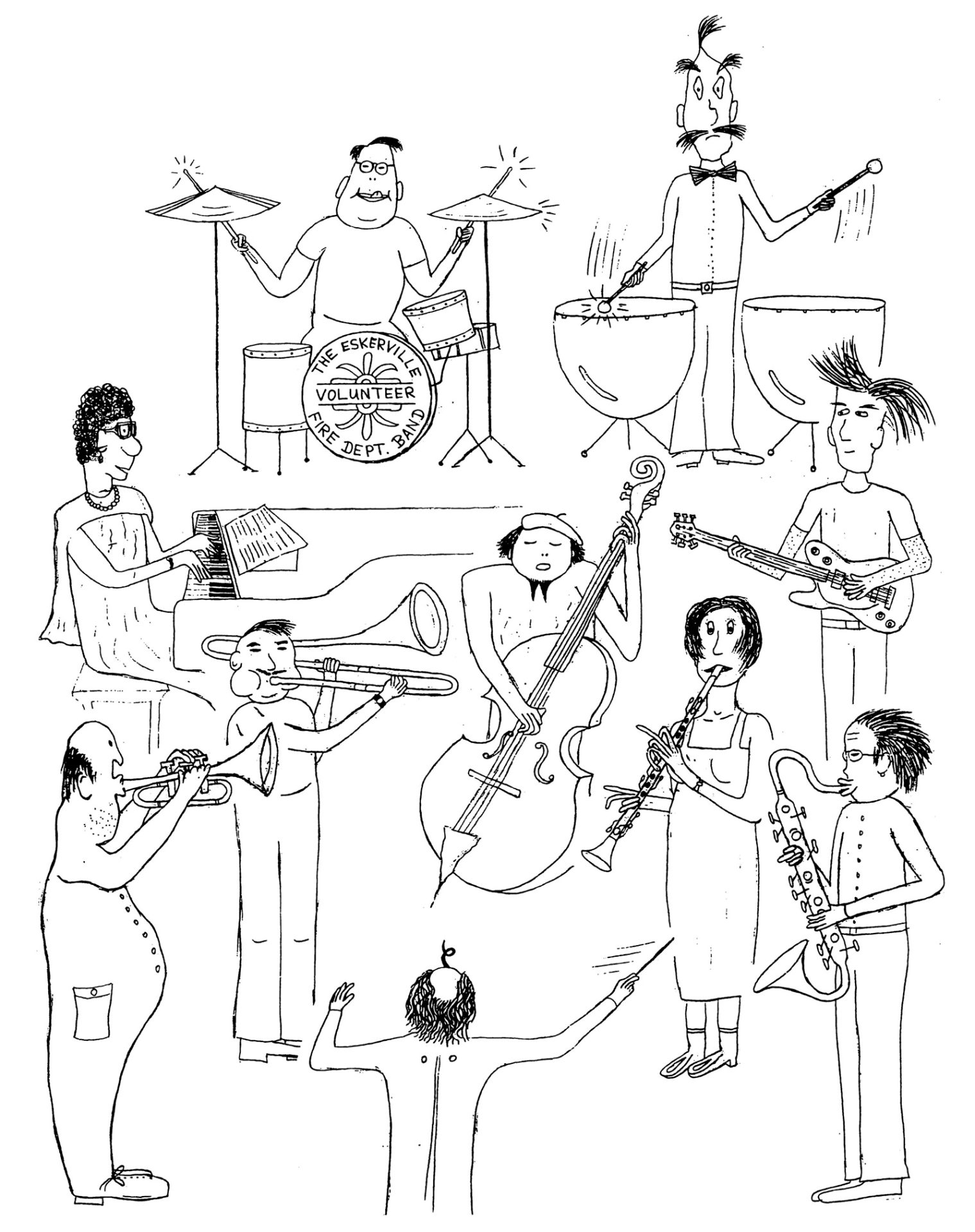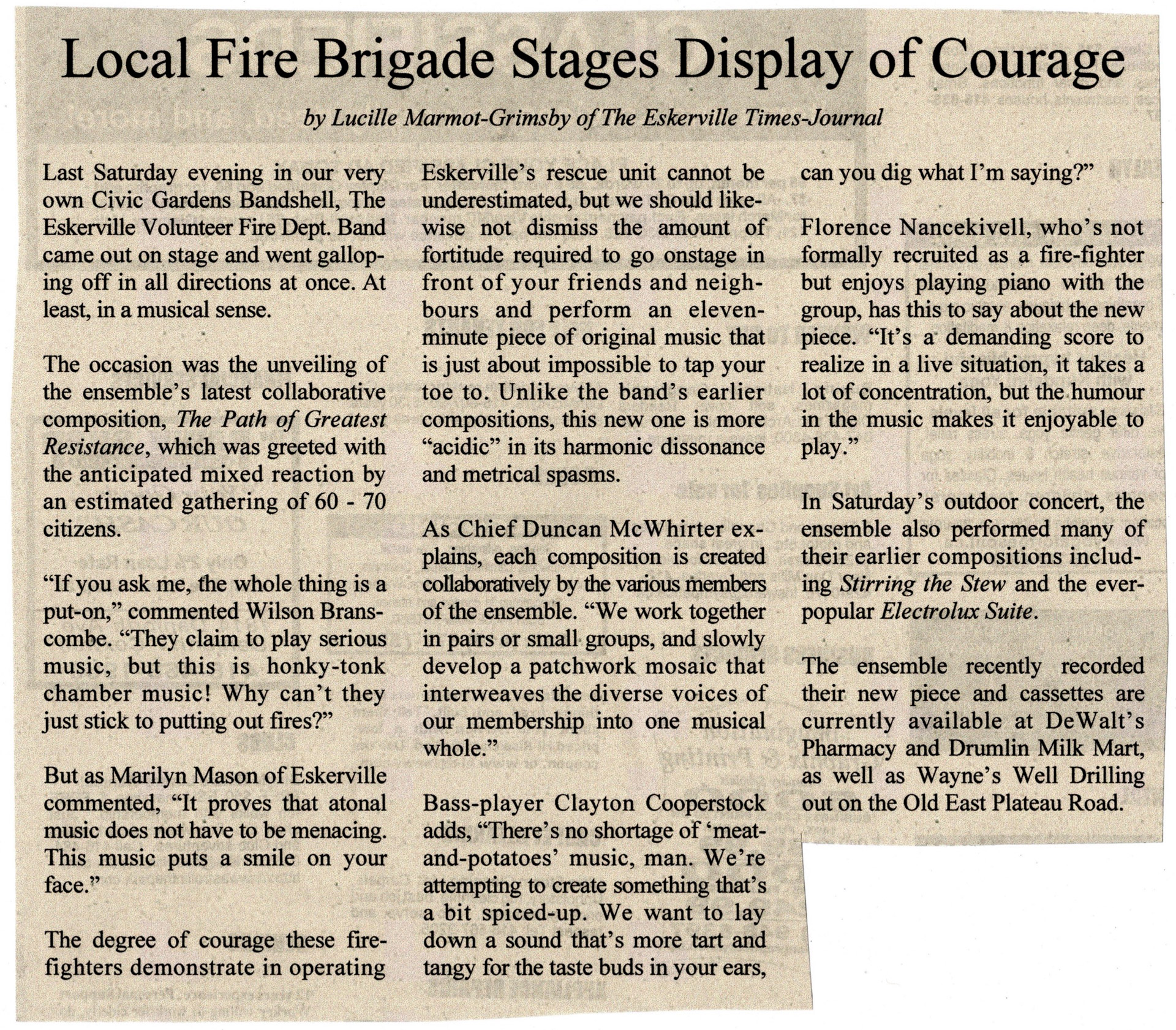The Eskerville Volunteer Fire Dept. Band
“Sounds like Igor Stravinsky, Lawrence Welk, Frank Zappa, and the Tijuana Brass all performing on stage at the same time.”
– Lucille Marmot-Grimsby, Eskerville Times-Journal

CONDUCTOR – Chief Duncan McWhirter / CLARINET – Heather Bagley / ALTO AND TENOR SAXOPHONE – Selywn Jasper Humphries / TRUMPET – Fred Wortley / TROMBONE – Jerry McKenzie / GRAND PIANO, SYNTHESIZER – Florence Nancekivell / ELECTRIC GUITAR – Rory Arsenault / ELECTRIC & ACOUSTIC BASS – Clayton Cooperstock / DRUM SET – Roydon Jeong / PERCUSSION STATION – Ed Sawchuk

Over the hills and far away, somewhere out in the vast scrublands of the Boreal Plateau, right where you’d least expect it, there’s an expansive green valley filled with bountiful farmlands and orchards. This pocket of unusual fertility is the product of a mysteriously unexplainable micro-climate known locally as “Clarence”, and it sustains a small population of enterprising folk who lead a self-sufficient existence almost totally devoid of contact with the “outside world”.
In the middle of this northern oasis is the region’s only municipality, the pastoral community of Eskerville (pop. 350) which is home to many good souls including the men and women of the local firefighting brigade.
With an ever-changing membership, The Eskerville Volunteer Fire Dept. is a rather assorted collection of characters, but when duty calls, this troupe can rendezvous in a matter of minutes anywhere within Moraine County.
In keeping with time-honoured tradition this volunteer fire brigade also has a small concert band, and on Thursday evenings they gather in Chief Duncan McWhirter’s basement to rehearse. Their annual performance schedule includes summer concerts in the Eskerville Civic Bandshell, numerous municipal parades, and a regular appearance at the Drumlin District Fall Fair.
Due to the voluntary nature of the unit’s recruitment, the band’s instrumentation tends to vary over time and can often be described as “interesting” at best (for a brief period in 1983, the instrumentation consisted of four French Horns and a banjo).
But it is perhaps the issue of repertoire that distinguishes this outfit from other fire-fighting consorts. Having long ago dispensed with the standard marches and medleys, this group of pyro-extinguishing tunesmiths has become a full-blown composers collective dedicated to performing their own original music for the “pleasure” of the local citizenry.
*******************************************
Some people, however, claim that Eskerville doesn’t really exist; that it is nothing more than a “mirage” on the horizon of the Boreal Plateau. But if you listen carefully, when the wind is blowing in the right direction, you can often hear in the distance the distinctive sweet‘n’sour strains of The Eskerville Volunteer Fire Dept. Band working hard on their next piece ……………. And how many mirages do you know that can make music?
FROM THE DESK OF
PROF. ALGERNON D. CRANFIELD, D.S.M., P.G.S.S.P., A.A.R., F.H.E.K.
I have been asked by Dunc McWhirter and his cohort to write a few words on their latest collaborative effort, The Path of Greatest Resistance.
Frankly, upon first listening, I wondered what I’d gotten myself into. It made no sense. I just didn’t get it. I’ve always considered the process of listening to music as analogous to exploring an aural landscape, and with this in mind, hearing The Path of Greatest Resistance for the first time was not unlike walking straight into a dense forest without trails or paths. I felt lost in a wild overgrown forest full of twisted roots, gnarled trees, and fungi-covered logs, and the experience left me yearning for music with a more symmetrical design; in other words, a formal garden. So I headed straight to the classical section of my record collection for a little Mozartian salvation.
However, upon subsequent listenings of The Path, I began to discover that certain parts of the great knotty forest were becoming familiar. Characteristic landmarks were starting to feel like old friends greeting me as I passed each time.
In this wild environment, organisms cross-fertilize in a natural uncultivated way, and grow instinctively, motivated simply by their raw determination to survive. This is a habitat where dissonant harmonies scrape gently across your face like prickly thorns on surrounding briers, irregular rhythms require concentrated footwork to avoid entanglement in twisted vines, and unpredictable melodic progressions create a delightful sense of disorientation, of not knowing which way is which.
One could easily elect to bushwhack one’s way through this kind of maximalistic music, but I’ve discovered the joy of clambering through the underbrush, experiencing each note in close contact and letting the music envelop me (I highly recommend playing the music loudly or listening with headphones for this intimate perspective).
What The Eskerville Volunteer Fire Dept. Band has created is essentially a work of folk art in their chosen medium of moving air molecules. Like a lot of primitive painting, the musical output of this ensemble is characterized by bold, vivid colours with solid, graphic contours concentrated within the frame so tightly that certain elements become distorted. The music is ornate but not particularly sophisticated, which is no surprise considering that few members of this organization have any formal music training.
If art truly mirrors life, then this particular work reflects a life that is continually evolving, at times rather clumsily, at times more gracefully, but never actually coming to a finite conclusion. In other words, the journey does not necessarily lead to the ‘grand resolution’ as championed by many forms of popular music. Instead, The Path of Greatest Resistance follows a rather eccentric course, forever wandering off-axis, backtracking, sidestepping, and somehow never quite arriving.
Makes you wonder what mystery tour The Eskervilles will lead us on next time.
Professor Cranfield is a musicologist who has lectured at many universities across North America. Having recently retired, he currently resides in his hometown of Eskerville. He is most noted for having once blown an entire enchilada through an E-flat alto horn.


